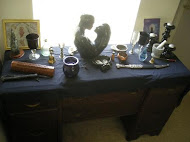I know this is isn’t my usual “herb” post, but unfortunately I am facing time constraints at present. Hopefully everything will be back to normal soon! My thanks to Diane Fenster for compiling this information, and saving my morning :)
* The Curious Lore and Magical Property of Plants: Blackberry *
Taken in entirety From: Notes from Diane's Garden By Diane Fenster; published in the Compost NewsLetter

Picture courtesy of Asparagus PlantRoots
“Leaving behind the baneful herbs of the dark time, we move on into the light of Brigid, the triple goddess of healing, poetry and smithcraft. Since the garden at Mount Bubba is amply supplied with bramble patches, I shall certainly make use of them for my Brigid ritual. Might I suggest that you, dear reader, do the same next year.
Brigid, also known as Candlemas, is the day that the sun comes out from behind the shadow of Mount Bubba so my house receives more light. I celebrate this day by filling the house with candles and welcoming the return of the sun. According to Robert Graves in The White Goddess, the Bramble or Blackberry is sacred to the Brigid triad of Goddesses so this months' notes will show us the folklore behind this plant. For more information on the history and symbolism of Brigid, both as a Goddess and a Saint, I refer you to Barbara Walker's Women's Encyclopedia of Myths and Secrets.
Rubus fruticosus is the Latin name, rubus meaning red. The brambles are in the same family as roses and apples. The name bramble is derived from brambel or brymbyl, meaning prickly. Culpepper tells us that it is a plant of Venus in Aries and the leaves of the plant should be gathered in the hour of the planet that governs the plant in question. Blackberries are supposed to give protection against evil runes. The whole plant has a great history of use as a charm, because it was a symbol of the triple Goddess, and for medicinal purposes.
There is a custom against eating blackberries in Cornwall since the plant is sacred to Brigid. In many other rural English areas, there is also a taboo against the Blackberry because the plant is associated with Satan. It is said that Satan was cast out of heaven on Old Michaelmas Day, October 11. Blackberries could not be gathered or eaten after that date, since they had been spit upon by the Devil when he fell into a patch of brambles and would be poisonous or bitter.
The following spell for burns and scalds makes use of the Blackberry. Since Brigid is the Goddess of Smithcraft, a profession which was filled with danger from burns, it makes sense that a charm for healing would make use of her sacred plant. It is interesting to note the two different wordings from different sources (The White Goddess and The Encyclopedia of Superstitions). For the first spell, the directions are to take nine bramble leaves and float them in a basin of water from a pure spring. Each leaf was then applied to the affected area and the invocation was repeated three times for each leaf. For the second spell, one is directed to use holy water to float the nine bramble leaves in, and to pass each leaf over and then away from the injured area while repeating the invocation three times.
Three ladies came from the East,
One with fire and two with frost.
Out with thee fire, and in with thee frost.
~A Cornish invocation to Brigid as a charm against scalds
There came three angels out of the east,
One brought fire and two brought frost.
Out fire, and in frost,
In the name of the Father, Son, and Holy Ghost.
~The same invocation showing the influence of the Church
There are a whole series of ancient beliefs regarding the efficacy of being passed through a naturally-occurring archway of either stone or plant material. It is symbolic of a rebirth, passing through the yoni of the Great Mother, represented by the archway. The following bramble-cure, which makes use of the growth habit of the plant to root at the tip of the branch when it reaches enough of a length and weight to touch the ground, is part of that series. The resultant archway acts as a magical doorway through which people (mostly children) and animals are passed through in order to cure various ailments such as boils, hernias, rickets, skin troubles, and whooping cough. In the case of cows, it is to cure Shrew-Mouse Evil, the malady (paralysis) that supposedly results from the animal being walked over by a shrew-mouse.
The root and the leaves contain a high proportion of tannin, so the plant is much used as an astringent and a tonic. The flowers and fruit were thought to be a cure for venomous snakebites and the young shoots, eaten in a salad, were supposed to fasten loose teeth. Crusoe's Treasury of Easy Medicines from 1771 recommends a decoction of Blackberry leaves to be applied to long-standing skin ulcers. There was even a hair dye made from boiling blackberry leaves and lye together, then applying it to the hair. It gives the hair a permanent soft black color. Blackberry juice gives us a gray dye on wool and slate blue on silk. The new shoots give a black dye.
The London Pharmacopoeia of 1696 proclaimed that the ripe berries were a superior cordial and were restorative in nature. Personally, I am extremely fond of Blackberries and one of my sweet memories is of a berry gathering expedition with my cousin through the fields of North Carolina on a beautiful summer day.
Mrs.. Grieve in A Modern Herbal has this recipe for a cordial that should restore one's spirits:
Press out the juice of ripe Blackberries, adding two pounds of sugar to each quart of juice. Add 1/ 2 oz. of nutmegs and cloves. Boil all together for a short time, allow to get cold and then add a little brandy.
A bit sweet for my taste, but as a ritual toast to Brigid on her day, well, that's another story.”
Disclaimer: No one involved in this blog or its contents may be held responsible for any adverse reactions arising from following any of the instructions/recipes on this list. It is the reader's personal responsibility to exercise all precautions and use his or her own discretion if following any instructions or advice from this blog.
















No comments:
Post a Comment